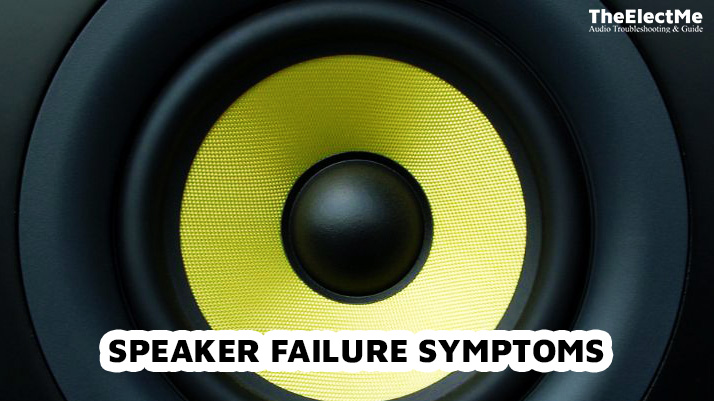A damaged wire, a blown-out speaker, or a faulty connection are common speaker failure symptoms. Recognizing these symptoms early ensures your audio equipment’s optimal performance and longevity.
When left unaddressed, speaker issues can worsen over time, potentially leading to more extensive damage. By being attentive to the signs of speaker failure, you can fix problems before they escalate.

Please read the article to learn the details of the signs of speaker failure and how to troubleshoot them effectively. Whatever your level of technical expertise, this guide will help you identify and fix speaker issues like a pro. Let’s start by understanding the most common symptoms of speaker failure.
Understanding Speaker Failure Symptoms And Causes
Understanding the common symptoms of speaker failure is essential for any audio enthusiast or professional. Here’s a breakdown of these typical signs:
- Distorted Sound Output: When your speakers emit distorted audio—fuzzy, muffled, or unclear—it suggests a possible problem with the components or connections.
- No Sound Output: Speaker silence may indicate electrical issues, blown drivers, or disconnected wires.
- Crackling or Popping Noises: Crackling or popping sounds from speakers indicate issues such as loose connections, damaged drivers, or interference impacting audio quality.
- Uneven Sound Quality: If sound levels or quality vary across frequencies or sources, it could indicate speaker performance issues, likely from damage or wear.
By identifying these symptoms early, you can diagnose speaker issues and effectively address them.
Causes of Speaker Failure
Exploring the underlying causes of speaker failure sheds light on potential reasons behind the symptoms experienced. Here are the key factors to consider:
- Overloading the Speakers: Playing music or audio at high volumes, exceeding the speaker’s capabilities. This can lead to speaker damage, particularly in low-quality or old speakers.
- Physical Damage: Speakers can experience physical damage from accidents, drops, or exposure to extreme temperatures. This damage can affect the internal components, resulting in speaker failure.
- Electrical Issues: Problems with the electrical connections or wiring can contribute to speaker failure. These issues can arise from faulty speaker magnets, damaged cables, or loose connections.
After understanding the common symptoms and causes of speaker failure, let’s explore the process of identifying these issues.
How to Spot Speaker Failure?
To identify speaker failure, visual inspection, and sound testing are crucial for pinpointing issues.
During a visual inspection, it’s essential to check the speakers for physical damage like dents, tears, or misalignments. Checking connections for looseness can reveal issues impacting the speaker’s performance.
Playing audio files across different genres and formats in sound testing can reveal irregular sound output. You can spot and correct early speaker issues by listening for distortions, crackling, or uneven sound. Regular visual and sound checks help keep speakers working at their best and prevent future failures.
After identifying the symptoms, it’s time to troubleshoot and fix speaker issues promptly.

How to Fix Speaker Failure?
There are a few steps to ensure proper troubleshooting and resolution when fixing speaker failure.
1. Checking Speaker Connections
Check the speaker’s wires and connections to address distorted sound or no output. Ensure the cables are securely connected to the speakers and the source device. Also, inspect for any frayed or damaged wires that may need replacement.
Using a different input source to troubleshoot uneven sound quality. This process helps identify if the issue lies with the speaker or the source device.
2. Adjusting Volume Settings
After you confirm that the speaker connection and source device are working, check the volume settings. High volumes can cause speaker overload, leading to damage. Adjusting the volume levels lower can help prevent further speaker issues.
To avoid damaging your speakers, always keep volumes at a reasonable level. However, it’s time to explore other fixes if the sound quality remains uneven or distorted at low volumes.
3. Replacing Damaged Parts
When the speaker’s physical component is damaged or worn out, replacing it may be necessary. Some elements commonly need replacement, including the diaphragm, tweeters, and woofers.
Replacing these parts can significantly improve the sound quality and extend the speaker’s lifespan. Make sure to purchase compatible parts for your specific speaker model. If you need more clarification or are uncomfortable replacing components, seek professional help.
4. Cleaning the Speaker
Dust and debris can accumulate in speakers over time, impacting their performance. Regularly cleaning your speakers can prevent sound issues and extend their life span. Use a soft cloth to clean the speaker’s exterior and a compressed air canister to remove dust from the internal components.
Please avoid using liquids or abrasive materials while cleaning the speaker, as they can damage its delicate parts.
5. Consider Upgrading
If your speaker continues to experience issues even after troubleshooting and maintenance, consider upgrading. As technology advances, so do speakers’ capabilities and sound quality.
Upgrading to a new set of speakers can enhance your audio experience and prevent frequent speaker failures. Research thoroughly and invest in a high-quality speaker model that meets your needs and budget.
When to Seek Professional Help?
When troubleshooting or maintenance fails to resolve speaker issues, it’s best to seek professional help. A qualified audio technician can diagnose and fix complex speaker problems effectively.
Contact tech support services provided by the speaker manufacturer or reputable repair services specializing in audio equipment. These professionals have the knowledge and tools to diagnose and fix complex speaker problems.
Determining Professionalism:
To determine professionalism, the following factors can be considered:
- Credentials: Look for certifications or qualifications in audio engineering or electronics repair.
- Experience: Check review testimonials or ask for references to gauge their expertise in speaker repairs.
- Communication: A professional will communicate, explain the issue, and offer transparent service pricing.
- Warranty: Ensure they offer warranties on their repair services to guarantee the quality of their work.
By assessing these factors and reaching out to qualified professionals, you can entrust your speaker repair needs to capable hands, ensuring a successful resolution. You can also estimate how long your car speaker lasts.
Final Thoughts – Speaker Failure symptoms
To summarise, your speakers’ health is essential to ensure a quality audio experience. Regular visual and sound checks, proper maintenance, and prompt troubleshooting can prevent speaker failure. Consider seeking professional help to diagnose and fix complex speaker problems in case of persistent issues.
Your speakers can provide impeccable sound output for years with proper care and attention. Remember, prevention is always better than cure! So, pay attention to early signs of speaker failure and take proactive steps to maintain and protect your audio equipment.
Keep enjoying your favorite tunes with high-quality, fully functional speakers.

